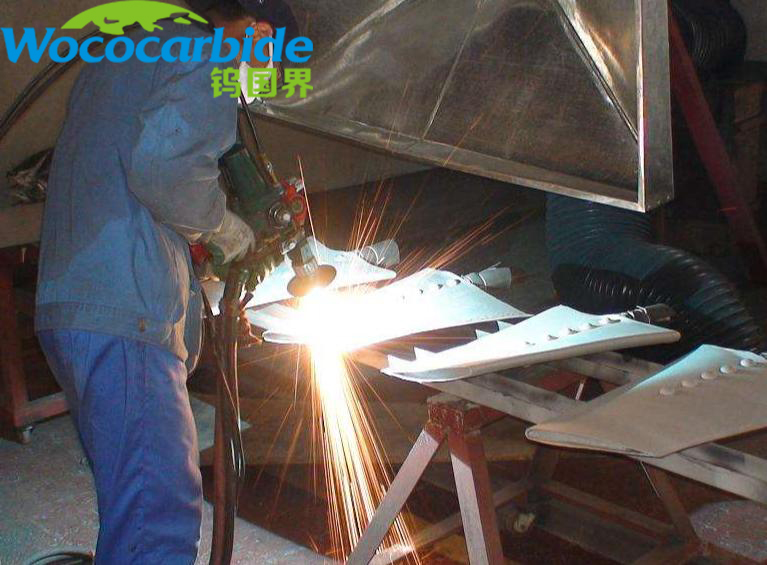

Powder flame coating uses oxyacetylene flame as heat source and powder coating as coating material. This technology is a new coating method after flame coating. The equipment is simple and the coating materials are various. It is currently the most widely used thermal coating technology in China.

1. The principle of spraying.
Powder flame spraying is a powder flame spray gun. Oxygen and acetylene are respectively introduced into the spray gun through the siphon nozzle, and after mixing, a combustion flame is generated at the nozzle outlet. Through the negative pressure generated by the airflow, the powder in the powder hopper is extracted, and the powder is sprayed from the center of the nozzle to the flame with the airflow, heated or softened, and the flame flows to the surface of the workpiece to spray molten particles to form a coating. In order to increase the flight speed of the particles, some spray guns have compressed air nozzles through which additional thrust is applied to the particles.
The powder melts from the surface layer into the core during the heating process, and the melted surface layer tends to be spherical under the action of surface tension, and there is no atomization process in which the powder particles are broken again. Therefore, the size of the powder particles determines the size and surface roughness of the deformed particles in the coating to a certain extent. In the process of being heated and accelerated by the flame, due to the different positions of the gunpowder in the flame, the degree of heating of the gunpowder is also different. Some gunpowder is melted or semi-melted, and some gunpowder is only softened or semi-softened. This method is very different from the melting atomization process of wire flame spraying, so that the bonding strength and compactness of powder flame spraying coatings are generally lower than those of wire flame spraying.
2. Equipment
The composition of the powder flame spraying device is similar to that of the linear flame spraying, and it is also composed of an oxyacetylene spraying system, a compressed air spraying system, and a spray gun. The biggest difference is in the spray gun. When the gun doesn't need compressed air, the system doesn't need to supply it. For powder feeding outside the gun, a powder feeder needs to be added.
There are many types of gunpowder flame spray guns. The representative ones in China are: QT-E-7/h and QT-E2000-7h produced in Shanghai, CP-3000 subsonic spray gun produced in Chengdu, and American Metco company. 5P and 6P two kinds. Although different types of spray guns have different structures, they are basically composed of two parts: the flame combustion system and the powder feeding system.
Type 3000 subsonic spray gun is a high-speed welding powder spray gun which uses oxygen-acetylene flame as heat source and compressed air as powder feeding gas, accelerating gas and cooling gas. Its unique spiral mixing and jet-suction intake structure can significantly improve the flame combustion efficiency and power. By choosing different nozzle components, the spray gun can spray carbide coatings with excellent performance and alumina and zirconia coatings of high melting point materials.
3. Characteristics of coating and process technology
1. Structural characteristics of the coating. The acetylene oxide flame sprayed the powder, the coating structure is also layered, and the coating contains oxides, pores and a small amount of incompletely deformed particles. There is a mechanical bond between the coating and the substrate. The spraying material and spraying process have a great influence on the porosity and bonding strength of the coating, generally 5~20%, and the bonding strength is 10~30MPa.
2. Process characteristics. Oxygen-acetylene flame powder spraying technology is currently widely used spraying technology, with the following characteristics:
The equipment is simple, the operation is convenient, the cost is low, and it is convenient for on-site construction.
The spraying process is simple, easy to master, and widely used.
3. Wide range of spraying materials, can spray a variety of metals, alloys, composite powders, ceramics, plastics and other materials.
4. It has large porosity and low residual stress, and can be sprayed into a thick layer.
Fourth, the main process parameters
1. Heat source parameters. During processing, the characteristics of the flame should be properly used and controlled, that is, a neutral or slightly carbonized flame should be used during preheating and powder spraying to avoid oxygen on the workpiece surface and powder. In general, powder flame spraying relies mainly on flame acceleration to spray particles. Under the condition of large flow of oxygen-acetylene, the power of the flue gas flow field is large, the flying speed of the jet particles is high, the bonding strength of the coating is high, and the density is high;
Second, the spray distance. The distance between the muzzle and the spraying surface of the workpiece is generally controlled between 150-200 mm. The specific value is determined according to the model of the muzzle, the power size and the length of the flame uprightness. The appropriate distance is to heat the alloy powder in the flame. The brightest part is aligned with the workpiece surface.
3. Substrate temperature. The workpiece should be preheated before spraying. The preheating temperature of steel parts should be between 80-120℃. The overall temperature of the workpiece should not exceed 250℃ during spraying.
Hot information

